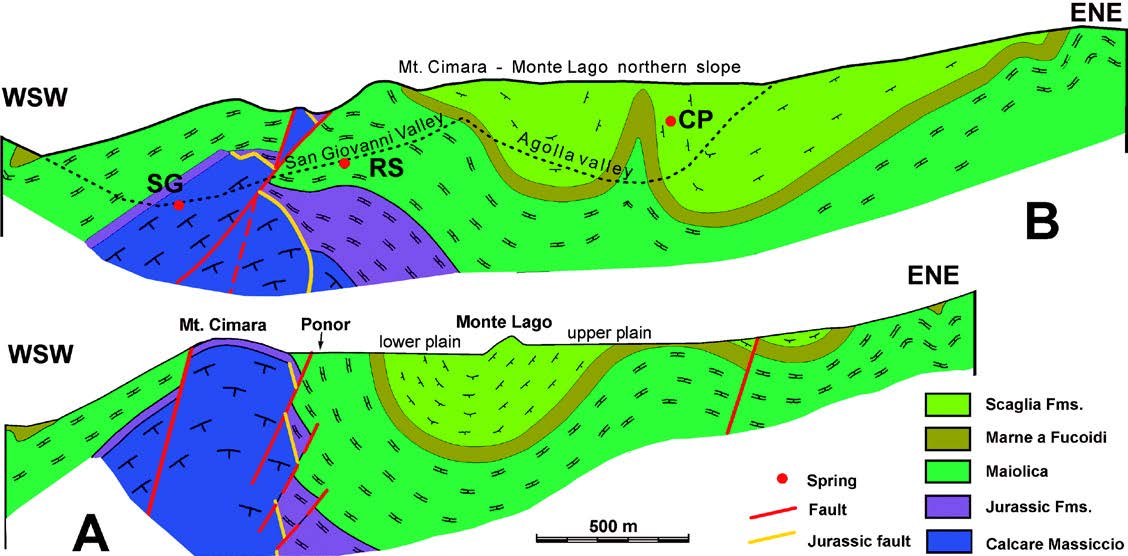Monte Lago polje, a case study regarding the influence of geologic structure and degree of karstfication on groundwater drainage in the Central Apennines (Italy)
DOI:
https://doi.org/10.3986/ac.v48i1.6872Keywords:
Monte Lago, Central Apennines, Karst, Groundwater monitoringAbstract
Research on the cave and karst water in the area of Monte Lago polje (Central Apennines) has revealed an articulate drainage pathway, influenced by the karstfication degree and geological setting. A fast drainage occurs from the ponor in the polje to the main temporary resurgence in the valley of San Giovanni, impeding the karst water in achieving thermal equilibrium with the rock. The water temperature in the resurgence decreases to very low values (~3 °C) during the winter, and the daily thermal cycles are clearly recognizable. These inputs of vadose water from the ponor have only a minor influence on the chemo-physical characteristics of San Giovanni spring, the largest emergence in the area, located a few hundred meters downstream in the same valley and fed by the main basal aquifer. The two nearby springs are recharged by different hydrostructures divided by low permeability levels in the Jurassic carbonate succession. This reduces the cross-formational communication mainly for the descending vadose fluxes. The fast drainage of karst water in the transfer vadose zone is due to a high karstfication, confirmed by the typology and distribution of the karst caves. A more regular discharge in the springs fed by the basal aquifer is probably related to a minor karstfication in the lower part of the limestone massifs.
Key words: Monte Lago, Central Apennines, Karst, Groundwater monitoring.
Kraško polje Monte Lago, študija vpliva geološke zgradbe in stopnje zakraselosti na tok podzemne vode v Centralnih Apeninih (Italija)
Raziskave jam in kraške vode na območju kraškega polja Monte Lago (Centralni Apenini) so razkrile obstoj drenažne mreže, na katero vplivata stopnja zakraselosti in geološka zgradba. Med ponorom na polju in glavnim občasnim izvirom v dolini San Giovanni se pojavlja hiter tok, ki preprečuje uravnoteženje temperature vode s temperaturo kamnine. Pozimi ima voda v izviru zelo nizko temperaturo (~3 °C), jasno so vidni dnevni temperaturni cikli. Ti dotoki vadozne vode iz ponora imajo le majhen vpliv na fizikalno-kemijske značilnosti izvira San Giovanni, največjega izvira na tem območju, ki je lociran nekaj sto metrov dolvodno v isti dolini in se napaja iz glavnega spodnjega vodonosnika. Dva sosednja izvira se napajata iz različnih hidrostruktur, ločenih s plastmi slabše prepustnosti v jurskem karbonatnem zaporedju. To zmanjšuje prehajanje predvsem navzdol tekočih vadoznih vod skozi formacije. Hitro pretakanje kraške vode v vadozni coni je posledica dobre zakraselosti, ki jo potrjujeta tipologija in razpored kraških jam. Bolj enakomeren pretok izvirov, ki se napajajo iz spodnjega vodonosnika, je verjetno povezan z manjšo zakraselostjo v spodnjem delu apnenčastega masiva.
Ključne besede: Monte Lago, Centralni Apenini, kras, monitoring podzemne vode.
Downloads

Downloads
Published
How to Cite
Issue
Section
License
Authors guarantee that the work is their own original creation and does not infringe any statutory or common-law copyright or any proprietary right of any third party. In case of claims by third parties, authors commit their self to defend the interests of the publisher, and shall cover any potential costs.
More in: Submission chapter




